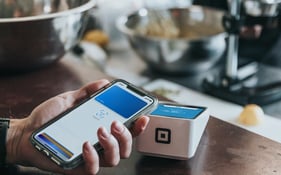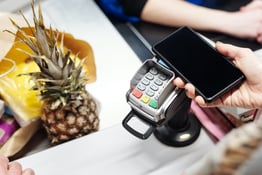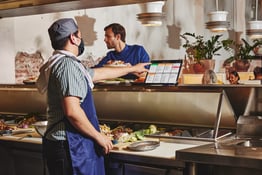QR codes have been around since the ‘90s, but the pandemic caused usage to surge. These days, seemingly every restaurant has an option to scan a little black-and-white square on your smartphone to retrieve the menu. Sometimes it’s the only option. But the reasons restaurants are using QR codes have evolved. Rarely is reducing COVID-19 now a top motive, or really a motive at all.
There are more relevant benefits, like saving time and money, that impact operations on a widespread level. Yet, not all restaurant owners are sold on the idea of using digital menus forever.
“Music sounds better on vinyl, you know? It just is what it is,” says 13th Street Kitchens co-owner Michael Pasqaurello, who’s brought back paper menus at four out of five restaurants, with his fifth soon to follow. “If we’re not going to make anyone sick, I just think it’s a better experience as a part of going out to eat.”
As restaurants increasingly return to paper, reports show it’s a move many customers favor. But with profit margins getting squeezed thinner and thinner, there’s an argument to keep QR codes due to an extending utility beyond menu display. We take a look at the future of QR codes in the restaurant space and why they’re likely to become a permanent, but not universal, fixture of the industry.
Paper menus are shifting to the norm again for fine dining restaurants. But as supply chain and staffing challenges continue, QR code menus will remain common elsewhere.
Some digital menu platform companies are starting to report a decline in clients seeking QR code menus. But that doesn’t mean business is drying up all together. Benefits like allowing operators to update menu prices in real time and save on printing give QR codes longevity, especially in today’s climate.
“We’ve definitely seen demand fall, but we do have quite a few clients who are continuing to use [QR code menus] because of the convenience factor of not having to print and redesign menus all the time,” says Colin Laberge, co-founder of ordering and digital menu platform MenuLabs. “Out of the last customers we’ve received, I’d say around eight of them were looking for a way to easily adjust pricing as their costs fluctuate.”
Supply chain fluctuations, coupled with inflation, are forcing many operators to make constant menu tweaks, and QR code menus assuage that challenge by making it easy to update pricing and availability. Virtual menus are also helping some restaurants with another hot topic – staffing challenges. Menus built with self-serve ordering capabilities eliminate the need for a server to stop by every table to take orders. And now that most people are familiar with how to use a QR code, many operators feel this model makes a lot of sense.
“QR codes help us save time and shave a little bit of labor, and we’ve found in more casual environments, guests simply need less attention,” says Kelly Phillips, founder of Destination Unknown Restaurants.
Phillips plans to keep QR code menus indefinitely at her restaurant Las Gemelas, but her decision was selective. Recently, paper menus were reinstated at Phillips’ higher-end Destino.
“We’re finding there’s this return to finer dining after being under lockdown for years where people want to treat themselves,” says Phillips. “People want to ask questions and talk to a server, and they want to be taken care of, and QR code menus don’t make as much sense.”
For casual dining, QR code self-serve ordering – and its capacity to boost sales – will grow.
QR code menus with self-serve ordering capabilities allow customers to pull up a menu, order, and pay, all from a mobile device. Usage of this feature is likely to grow at restaurants where delivering quick and affordable meals is a higher priority than a memorable sit-down experience.
The obvious benefit is the decrease in labor needs and costs. But digital menu platforms are working to expand the advantages beyond staffing. Menu management platform Menuflow, for example, says its self-serve ordering model contains automated features that increase check size by an average of 20%.
“We spent a lot of time looking at what the server does that technology typically doesn’t do – that’s things like food pairings and upsells,” says Menuflow founder and CEO Steve Wright.
Menuflow’s self-serve platform works to fill those gaps, making suggestions for each customer based on what items they’re choosing. Order shrimp scampi, and the platform may suggest adding on tiramisu, for example. Order fries, and you may be prompted to level up to a loaded version. The goal is to boost check size. And there are an array of other emerging QR code features, some as simple as displaying photos with each menu item, designed to do the same.
QR code payment options may surpass QR code menu usage at full-service restaurants.
At higher-end restaurants, few people want to sit down and place their own order through an electronic device. You’re paying for an experience that includes human connection and ease of asking questions. But, the option to pay the check on your own time may bring greater appeal.
“[Paying] is one of the biggest time-killers of servers and frustrations for guests,” says Wright. “You have guests waiting around for the server, then typically the server has to run and bring back the card machine, and that whole process can take 10 to 15 minutes.”
Let’s say you’re running late for a post-dinner show. With pay-at–the-table technology, you can pay in seconds and get on your way, while your server gains back more time to spend at other tables. Restaurants don’t need to use a QR code menu to take advantage of this technology, so it’s likely we’ll see more restaurants across the entire industry test out a hybrid approach – let customers choose between closing out with their server and using a QR code.
Most current solutions enable servers to see customers’ payments immediately, designed to help avoid literal “dine ‘n dash” incidents. But that could be the largest drawback of pay-at–the-table solutions. While the technology frees up staff from some of the back and forth to the POS, they’ll still need to keep a close eye on tables unless payment is required upfront.
Customers will continue to call for the return of paper menus. And return, they will.
Plenty of diners long for the days where staring at a smartphone wasn’t part of the dining experience. In a recent survey of 1,000 consumers by food industry consulting company Technomic, 88% of respondents said they preferred paper menus to digital QR codes, and 57% of respondents said using QR codes feels like a chore.
The penchant for paper has pushed many restaurants to already ditch digital menus, with some operators saying the benefits simply don’t outweigh the experience of a tactile menu.
“The people working alongside me really liked the QR code [menu] because it didn’t get dirty, you didn’t have to reprint them, you could easily change a menu item. So there’s definitely positivity in it, but so many amazing experiences happen when you go into a restaurant, and I just think getting handed a menu is one of those things,” says Pasqaurello. “In our area [in Philadelphia], I’ve seen a lot of people come back to paper.”
Some restaurants reported a dip in average check totals after switching to QR-code menus. Factors like having an older, less tech-savvy customer base or a clunky QR-code experience that makes it frustrating to browse menu items could be to blame.
“If you did the QR code as a bandaid during COVID, those are the restaurants that will more than likely go back to paper menus,” says Bret Yonke, Technomic’s director of research and insights. “However, if you’re one of these larger, full-service chains that invested in technology where you can place your order and pay through it, or maybe even implemented a tablet menu before COVID, you’re probably not going back.”
QR code menus will increasingly be tied to loyalty programs and other restaurant offerings.
You scan a QR code, and before the menu loads, a pop-up takes over your screen: Click here to sign up for our loyalty program and get 10% off any appetizer!
As restaurants rapidly embrace loyalty programs to boost sales and bolster their customer base, menu management platforms are getting in on the action. Some platforms even allow operators to build a digital loyalty program into their actual QR code menu.
“We have a point system that’s tied to a customer’s mobile number, so every time they dine and check out, it saves their points and those points get converted into dollars,” says Menuflow’s Wright.
There’s a convenience QR codes create for signing up for restaurant offerings, including those beyond loyalty programs.
“People can inquire about classes and then sign up right at the table, so there’s certainly less friction,” says Troy Bowen, co-owner of Denver wine bar and restaurantNoble Riot, who’s seen an increase in signups for both Noble Riot’s wine classes and membership program.
What Bowen views as QR code’s greatest appeal, however, is the opportunity to further educate guests. Bowen recently started introducing an abridged paper menu with a QR code attached.
“I can highlight certain wines on the menu, but if you want more information, you get it directly through the link,” says Bowen. “Guests get a chance to educate themselves, and we can introduce podcasts or videos we did with certain winemakers – that’s what I think is really exciting.”
QR code menu features will continue to expand in ways that target increased profitability for operators and a better guest experience.
Picture a QR code menu that knows your tastes and preferences. For example, maybe you’re someone who frequently orders lasagna. Now, whenever you scan a menu at a restaurant that offers lasagna, lasagna always shows up at the top.
While currently in the early stages of development, that’s the kind of technology that MenuLabs hopes to introduce – a menu that dynamically pivots based on the user.
“There’s just so many possibilities with these QR code menus,” says Laberge.
Several companies recently started testing out dynamic menu pricing, enabling operators to automate price changes depending on factors like time of day, or even adopt surge pricing, similar to Uber’s model, where price shifts with demand.
We’ve seen QR code capabilities rapidly evolve just within the past few years, and advancements are only expected to continue as menu management platforms strive to hold onto customers and attract new ones.
“If you’ve been to China in the past 10 years, you see QR codes are now everywhere, from fast casual to fine dining,” says Laberge. “America doesn't always follow in lock step with what China does, but it’ll be interesting to see how it pans out, and I think the staffing shortage and the dynamics of costing will really be a big function of that here.”
Grace Dickinson is a reporter at Back of House. Send tips or inquiries to grace@backofhouse.io.
[Photo courtesy Tim Douglas]





